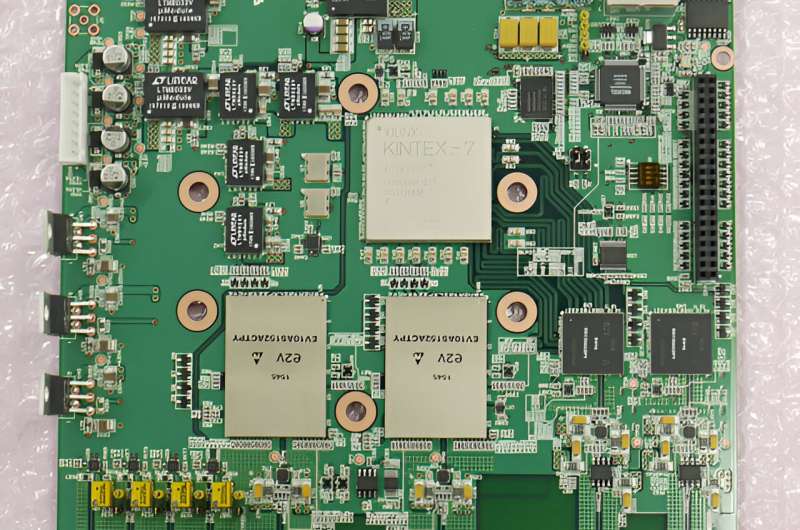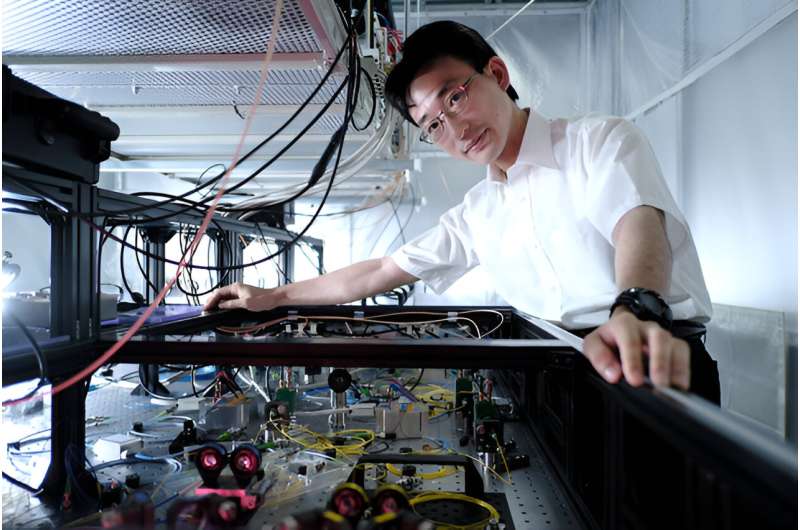Atsushi Sakaguchi and his team are exploring the possibility of using light to produce measurement-based rather than gate-based quantum computers. Image source: RIKEN
The race to develop quantum computers has really heated up over the past few years. State-of-the-art systems can now run simple algorithms using dozens of quantum bits, or qubits, the building blocks of quantum computers.
Most of these successes have been achieved in so-called gate-based quantum computers. These computers use physical components, particularly superconducting circuits, to host and control qubits. This approach is very similar to traditional, device-based classical computers. Therefore, the two computing architectures are relatively compatible and can be used together. Furthermore, future quantum computers could be built using the same techniques used to build conventional computers.
But the optical quantum computing research team at the RIKEN Quantum Computing Center in Japan took a completely different approach. Atsushi Sakaguchi, Jun-ichi Yoshikawa, and team leader Akira Furusawa have been developing measurement-based quantum computing rather than optimizing gate-based quantum computers.
Measurement-based calculations
Measurement-based quantum computers process information in complex quantum states called cluster states, which consist of three (or more) qubits linked together by a non-classical phenomenon called entanglement. Entanglement is when the properties of two or more quantum particles remain connected, even when separated by great distances.
Measurement-based quantum computers work by measuring the first qubit of a cluster state. The result of this measurement determines what measurement is performed on the second entangled qubit, a process called feedforward. This then determines how to measure the third one. In this way, any quantum gate or circuit can be implemented by appropriately choosing a series of measurements.
Measurement-based schemes are very effective when used on optical quantum computers because it is easy to entangle large numbers of quantum states in optical systems. This makes measurement-based quantum computers potentially more scalable than gate-based quantum computers. For the latter, qubits need to be precisely fabricated and tuned to achieve uniformity and physically connected to each other. These problems can be solved automatically through the use of measurement-based optical quantum computers.
Importantly, measurement-based quantum computing provides programmability of optical systems. “We can change the operation just by changing the measurement,” Sakaguchi said. “This is much easier than changing the hardware, as gating-based systems are needed in optical systems.”
But feedforward is indispensable. “Feedforward is a control method where we provide measurements to different parts of the system as a form of control,” Sakaguchi explains. “In measurement-based quantum operations, feedforward is used to compensate for the randomness inherent in quantum measurements. Without feedforward operations, measurement-based quantum operations would become probabilistic, while actual quantum operations would need to be deterministic of.”
An optical quantum computing research team from the University of Tokyo, the University of Palak in the Czech Republic, the Australian National University, and the University of New South Wales in Australia and colleagues have now demonstrated a more advanced form of feedforward: nonlinear feedforward. Achieving a full range of potential gates in optical-based quantum computers requires nonlinear feedforward.Research results published in journal nature communications.
“We have now experimentally demonstrated nonlinear orthogonal measurements using a new nonlinear feedforward technique,” Sakaguchi explains. “This type of measurement has previously been a barrier to achieving universal quantum operations in quantum computing based on optical measurements.”

Gate-based quantum computers are becoming increasingly common. But the optical quantum computing research team at the RIKEN Quantum Computing Center has been developing measurement-based quantum computing, as well as digital circuits for electro-optical control (pictured). Measurement-based systems may be more scalable than gate-based quantum computing. Image source: RIKEN
optical computer
Optical quantum computers use qubits composed of packets of light waves. At other institutions, some members of the current RIKEN team have previously established large optical cluster states required for measurement-based quantum computing. Linear feedforward is also implemented to construct simple gate operations, but higher order gates require nonlinear feedforward.
In 2016, a theory for practical implementation of nonlinear orthogonal measurements was proposed. But there are two main practical difficulties with this approach: generating special auxiliary states (which the team implemented in 2021) and performing non-linear feedforward operations.
The team overcame the latter challenge using sophisticated optics, special electro-optical materials and ultrafast electronics. To do this, they utilized a digital memory, in which the required nonlinear functions were precomputed and recorded in the memory. “After measurement, we convert the optical signal into an electrical signal,” Sakaguchi explains. “In linear feedforward, we just amplify or attenuate the signal, but with nonlinear feedforward we need a more sophisticated process.”
The main advantages of this nonlinear feedforward technique are its speed and flexibility. This process needs to be fast enough so that the output can be synchronized with the quantum state of the light.
“Now that we have shown that we can perform nonlinear feedforward, we hope to use the system we developed previously to apply it to quantum computing and quantum error correction based on real measurements,” Sakaguchi said. “We hope to increase the speed of nonlinear feedforward to enable high-speed optical quantum computing.”
“But the key message is that while approaches based on superconducting circuits may be more popular, optical systems are promising candidates for quantum computer hardware,” he added.
More information:
Atsushi Sakaguchi et al., Nonlinear feedforward supports quantum computing, nature communications (2023). DOI: 10.1038/s41467-023-39195-w
citation: Researchers take a different approach to measurement-based quantum computing (2023, December 21), Retrieved December 22, 2023, from https://phys.org/news/2023-12-approach-measurement- based-quantum.html
This document is protected by copyright. No part may be reproduced without written permission except in the interests of fair dealing for private study or research purposes. Content is for reference only.
#Researchers #approaches #measurementbased #quantum #computing
Image Source : phys.org
